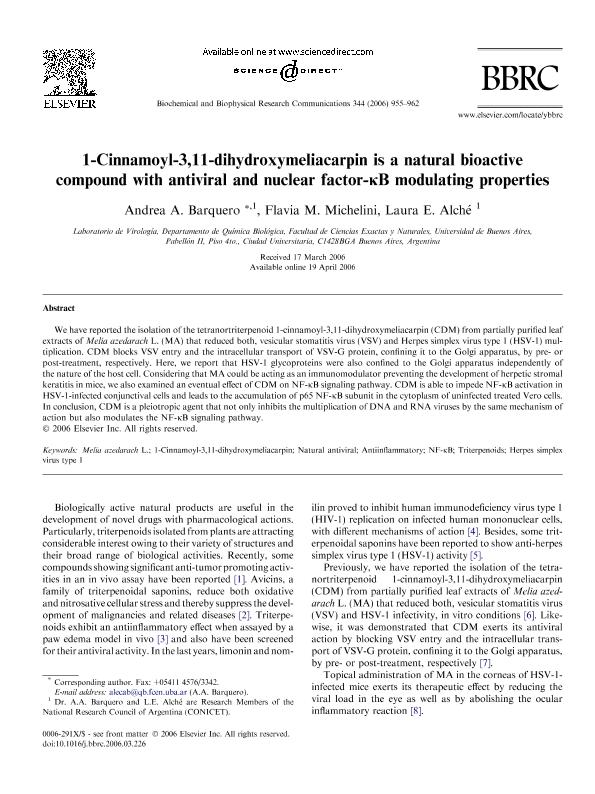Artículo
1-Cinnamoyl-3,11-dihydroxymeliacarpin is a natural bioactive compound with antiviral and nuclear factor-κB modulating properties
Fecha de publicación:
06/2006
Editorial:
Academic Press Inc Elsevier Science
Revista:
Biochemical and Biophysical Research Communications
ISSN:
0006-291X
Idioma:
Inglés
Tipo de recurso:
Artículo publicado
Clasificación temática:
Resumen
We have reported the isolation of the tetranortriterpenoid 1-cinnamoyl-3,11-dihydroxymeliacarpin (CDM) from partially purified leaf extracts of Melia azedarach L. (MA) that reduced both, vesicular stomatitis virus (VSV) and Herpes simplex virus type 1 (HSV-1) multiplication. CDM blocks VSV entry and the intracellular transport of VSV-G protein, confining it to the Golgi apparatus, by pre- or post-treatment, respectively. Here, we report that HSV-1 glycoproteins were also confined to the Golgi apparatus independently of the nature of the host cell. Considering that MA could be acting as an immunomodulator preventing the development of herpetic stromal keratitis in mice, we also examined an eventual effect of CDM on NF-κB signaling pathway. CDM is able to impede NF-κB activation in HSV-1-infected conjunctival cells and leads to the accumulation of p65 NF-κB subunit in the cytoplasm of uninfected treated Vero cells. In conclusion, CDM is a pleiotropic agent that not only inhibits the multiplication of DNA and RNA viruses by the same mechanism of action but also modulates the NF-κB signaling pathway.
Archivos asociados
Licencia
Identificadores
Colecciones
Articulos(IQUIBICEN)
Articulos de INSTITUTO DE QUIMICA BIOLOGICA DE LA FACULTAD DE CS. EXACTAS Y NATURALES
Articulos de INSTITUTO DE QUIMICA BIOLOGICA DE LA FACULTAD DE CS. EXACTAS Y NATURALES
Citación
Barquero, Andrea Alejandra; Michelini, Flavia Mariana; Alche, Laura Edith; 1-Cinnamoyl-3,11-dihydroxymeliacarpin is a natural bioactive compound with antiviral and nuclear factor-κB modulating properties; Academic Press Inc Elsevier Science; Biochemical and Biophysical Research Communications; 344; 3; 6-2006; 955-962
Compartir
Altmétricas




